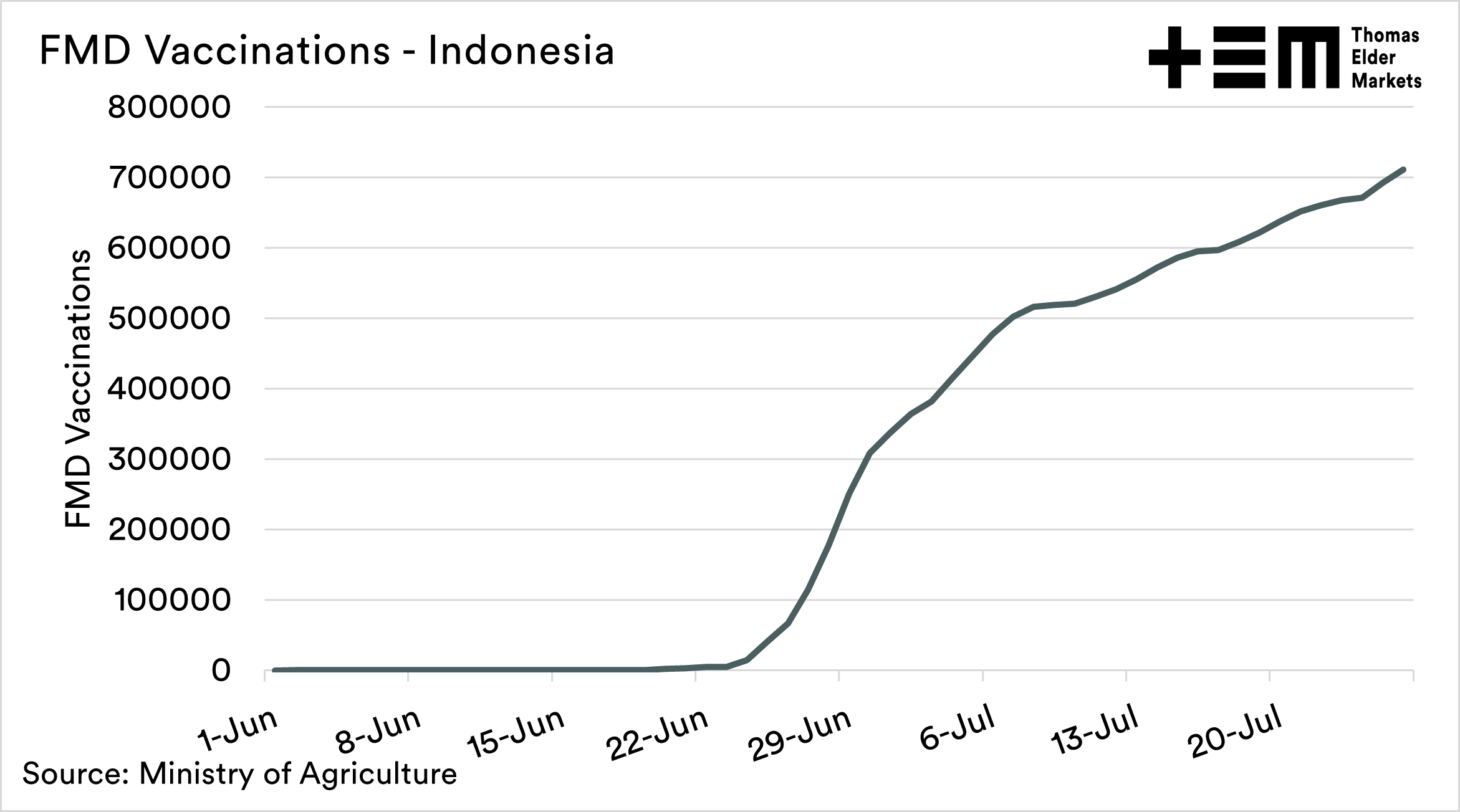Is the worst over for FMD in Indonesia?

The Snapshot
- FMD remains a severe risk if it arrives in Australia and infects a susceptible animal.
- In the 2001 UK outbreak, the peak daily caseload was on day 45. So far, in the case of Indonesia, it was on day 67, and we are now on day 97.
- If we trust the Indonesian government data, the case numbers have displayed a downward trend.
- The worst impacted region is East Java at 168 cases (39%), Bali has recorded 554 cases (0.13%).
- FMD vaccinations in Indonesia have reached 711k.
- Bali, considered the most risk for Australia, has the second highest ratio of vaccines to cases.
- The data is displaying some welcome trends*.
- It’s not over, as outbreaks come and go.
*If we take the data at face value
The Detail
At EP3, we have been covering FMD from before it was cool. When it was a small distant outbreak back in May. The following articles were published EP3 website to give you updates:
- The impact of FMD on the grain industry.
- A personal and trade perspective.
- As we get toey about FMD should we ban flights?
- The other disease risk
- What’s at risk?
If I say so myself, a pretty good set of insights for a free service. The FMD story is starting to get a little over the top now.
We need to calm down a little bit. FMD isn’t in the country at the moment; we don’t need to ban the Melbourne show, stop farmers from visiting zoos or cull the penguins at Sea Life. I made that last one up, but seeing that reported somewhere wouldn’t surprise me.
Risk at its most basic is probability vs severity. At present, the risk of an incursion is still relatively low, but clearly, an outbreak in Australia would have huge severity. The virus still has to get from an infected animal in Indonesia to a susceptible animal in Australia.
To get an outbreak, we need a number of errors to occur. It’s not impossible, but it is still low risk.
So let’s delve into some detail.
Indonesia
The concern at the moment is Indonesia, due to the large travel volume between our two nations. So I thought it was worthwhile looking at some data on how they are handling their outbreak.
The Indonesian Ministry of Agriculture maintains a good dataset on the outbreak. There are always issues around data veracity, but I will take it at face value for this analysis – unless someone can point to a better data source.
The peak day for new FMD cases in Indonesia was on the 26th of June, with 13.4k cases. Since then the number of cases has been trending down, with the ten day average at 2.7k cases. The chart below shows the daily caseload of FMD in Indonesia.
If we can trust this data, this is a good sign for the Indonesian outbreak. The data shows that the spread of infections, or at least reported infections, is declining significantly.
The chart below shows the cumulative caseload, which is now starting to taper off. The fewer cases in Indonesia, the lower the risk of an incursion into Australia.
In the 2001 UK outbreak, the peak daily case numbers were around day 45; the current peak of this outbreak was on day 67. We are now on day 97.
As with any outbreak of disease, the country is not saturated. The FMD outbreak is not spread equally around Indonesia.
The heat map below shows the provinces where FMD cases have been declared. The most concerning region is East Java, with 39% of all cases (169k).
The outbreak which has caused the most trepidation has been Bali. Bali has had 554 cases or 0.13% of all cases.
The outbreak in Bali concerns due to the Australian love of the region. However, the case numbers remain low.
Vaccinations
With support from Australia, the Indonesian government has been vaccinating with gusto. As of today, they have vaccinated 711k animals across Indonesia.
This is still far from the sheer number of susceptible animals within the nation (est 16m). It is a good start and has been targeted to the places of most need.
When delving into the data, Bali, whilst only having only 0.13% of the nations cases, has received 4% of the nation’s vaccines.
The chart below shows the ratio of vaccines given to the number of cases reported in the province. South Sumatra and Bali have the highest ratio of vaccines.
This is potentially a good sign for the Bali risk, as it shows the Indonesian government have been active in this region of most concern (for us).
The data provided by the Indonesian government, if taken at face value, displays a downward trend in case numbers. This is welcoming for Australia, as lower case numbers reduce the risk.
I am not saying that it is over by any stretch of the imagination; we have seen with COVID that outbreaks come and go. The data, again, if taken at face value, shows a pleasing trend.
We need to remain vigilant at the borders and on our own properties. We also need to keep calm before our panic starts to cause unintended consequences to our markets.
Support EP3
Remember to sign up to make sure you don’t miss any of our updates, these are free to access. If you want to support this service, remember to share with your network.












